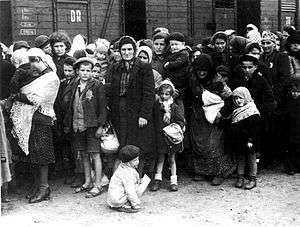Rabbis' march (1943)
| Part of a series on | ||||||||||
| The Holocaust | ||||||||||
|---|---|---|---|---|---|---|---|---|---|---|
 | ||||||||||
|
||||||||||
|
Atrocities |
||||||||||
|
Camps
|
||||||||||
|
Lists Deportations of French Jews
to death camps |
||||||||||
|
Remembrance |
||||||||||
The Rabbis' March was a demonstration in support of American and allied action to stop the destruction of European Jewry. It took place in Washington, D.C. on October 6, 1943, three days before Yom Kippur. It was organized by Hillel Kook, nephew of the chief rabbi of Mandatory Palestine and head of the Bergson Group, and involved more than 400 rabbis, mostly members of the Union of Orthodox Rabbis of the United States and Canada,[1] from New York and cities throughout the eastern United States.
Though the delegation was reluctantly received by Vice President Henry Wallace, President Franklin D. Roosevelt avoided meeting the rabbis, both out of concerns regarding diplomatic neutrality, but also influenced by the advice of some of his Jewish aides and several prominent American Jews. Many thought the protest would stir up anti-Semitism and claimed that the marchers, many of whom were both Orthodox as well as recent immigrants (or first-generation Americans), were not representative of American Jewry. Shortly before the protest reached the White House, FDR left the building through a rear exit to attend an Army ceremony, and then left for a weekend in the country. Disappointed and angered by the President's failure to meet with them, the rabbis stood in front of the White House where they were met by Senator William Warren Barbour and others, and refused to read their petition aloud, instead handing it off to the Presidential secretary, Marvin McIntyre.
The march garnered much media attention, much of it focused on what was seen as the cold and insulting dismissal of many important community leaders, as well as the people in Europe they were fighting for. The headline in the Washington Times Herald read: "Rabbis Report 'Cold Welcome' at the White House." Editors of The Jewish Daily Forward commented, "Would a similar delegation of 500 Catholic priests have been thus treated?"
Participants
Participating rabbis included the leading rabbinical figures of the era, including Rabbi Eliezer Silver and Rabbi Avraham Kalmanowitz of the Vaad Hatzalah. One of the participants was Rabbi Moshe Feinstein who become one of the most important and famous American Orthodox rabbis and Rabbi Eliezer Poupko, a prominent figure in the orthodox rabbinic world.
Holocaust museum petitions
On 29 July 2007, relatives of the rabbis who marched on Washington sent a letter to the United States Holocaust Memorial Museum, urging the inclusion of information about the Bergson Group and the Rabbi's March in the museum's permanent exhibit.[2] A similar petition, signed by 100 public figures, was delivered to Yad Vashem.[3]
References
- ↑ The Silver Era in American Jewish Orthodoxy: Rabbi Eliezer Silver and his Generation ISBN 0-87306-274-4
- ↑ "Petition By Relatives of Rabbis Who Took Part in the 1943 March in Washington". The David S. Wyman Institute for Holocaust Studies. 2007. Retrieved 21 December 2010.
- ↑ Fox, Tamar (23 June 2008). "Pointing Fingers and Awarding Holocaust Heroics—What's the Big Deal?". jewcy.com. Retrieved 21 December 2010.
Sources
- David S. Wyman Institute for Holocaust Studies. The Day the Rabbis Marched
- Jewish Virtual Library. When the Rabbis Marched on Washington